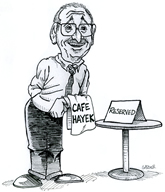As the 2025-2026 school year is about to begin, this piece by the Wall Street Journal‘s Editorial Board is worth reading, for it reminds us of this revealing fact: government-school administrators and teachers fear competition. [DBx: If an evil genius set out to design a system of K-12 schooling that is guaranteed to supply inferior education – and, to boot, one with racist consequences – while unjustly enriching the suppliers of that inferior product, that genius could have done no better than to design the K-12 government school system that reigns today throughout the United States. This school system has a captive audience everyone of whom must pay for its services regardless of whether or not that person uses those services, and regardless of how well or poorly the schools educate children. (Adam Smith argued strongly against such a system.) Tellingly, hordes of the suppliers of this poor product adamantly oppose having to compete; they (understandably) fear competition. If food distribution were organized in the way K-12 schooling is organized, poor and middle-income Americans would shop in grocery stores of the sort that were common in the Soviet Union, while rich Americans (able to afford private supermarkets) would alone be assured varied and healthy diets.]
A decade later, another famous economist made a similar observation about the internet — actually, a prediction: “By 2005 or so, it will become clear that the Internet’s impact on the economy has been no greater than the fax machine’s.” That was Nobel Prize winner Paul Krugman, who now has a highly profitable email newsletter.
We’re now hearing similar questions about artificial intelligence. If it’s so revolutionary, why don’t we see evidence that it’s replacing workers? Why hasn’t it transformed productivity statistics? How can these companies earn back the massive amounts they’re spending building data centers and training models? Isn’t all the doomcasting and wishcasting a load of hype? Aren’t we in an AI bubble that’s getting ready to pop?
The answer to that last question is yes, we’re possibly in a bit of a bubble, just as we were in an internet bubble in 1998, when Krugman made that prediction. I don’t want to say bubbles are a normal response to a major wave of technological innovation that makes it hard to tell what will work, or how much the things that work will be worth 10 or 20 years hence. But they’re an understandable response to that kind of uncertainty, as investors who are willing to bet on the future drive spending and valuations higher than reality will ultimately sustain.
…..
Another reason we might not be seeing immediate, large productivity improvements is that humans and machines are at the early end of the learning curve. When I was in college, I worked as a clerk at a firm that employed two top-notch legal secretaries. Those women, both in their early 50s, had started their careers on typewriters and could type more than 100 words per minute with few mistakes. They had also acquired an effortless mastery of legal forms that allowed them to quickly translate a lawyer’s handwritten notes into a flawless brief or filing. By the early 1990s, they were both using word processors, but how much time was that actually saving them? Some definitely, but the real productivity gains came later, when lawyers could type documents directly into a computer, much faster than they could dictate or write them out by hand, and firms didn’t need to employ so many legal secretaries.
The real Trump Derangement Syndrome shows up in three telltale symptoms.
First is the cult-like worship that treats Trump as infallible — his acolytes profess adoration not only for what he does, but for whatever could flow from him.
Emblematic of that mindset are the “Trump Was Right About Everything!” baseball caps, which the president himself prominently displayed in the Oval Office in February 2025. The caps are intended less as a joke than as a badge of faith. They echo Trump’s infamous boast about being able to “stand in the middle of Fifth Avenue and shoot somebody and [not] lose any voters.” For some in his base, there is literally nothing he could do that would shake their devotion. The more outlandish the president’s deeds or words, the more his enthusiasts praise his strategic genius and his mastery of four-dimensional chess.
Second is the abandonment of principles that once seemed non-negotiable. Conservatives and Republicans who used to champion free trade now cheer Trump’s tariffs. Those who formerly prized NATO as a linchpin of global security today nod in agreement when Trump disparages America’s allies. Republicans once railed against Barack Obama’s and Joe Biden’s “pen-and-phone” executive actions, yet they applaud as Trump goes far beyond his predecessors in ruling by executive decree. To those afflicted with TDS, principles are expendable and whatever Trump says or does must be defended. Yesterday’s bedrock conviction becomes today’s expendable talking point.
Third is the unsettling delight so many supporters take in Trump’s most outrageous behavior — a kind of giddy worship that equates offensiveness with authenticity. Such brazenness has been a hallmark of his political career — from mocking John McCain’s Vietnam War heroism to charging undocumented immigrants with poisoning the blood of our country” to calling for “one really violent day” to end property crime. The more extreme the rhetoric, the more MAGA true believers praised it — as if outrage were the highest form of loyalty. The Trump hard core doesn’t just tolerate or excuse infamy; many revel in it.
Meanwhile, they reflexively use “TDS!” as a go-to put-down for anything from mild disagreement to serious moral critique, framing opposition not as argument but as pathology — an easy, cheap discredit. Yes, plenty of Trump-haters go overboard — but in MAGA circles, the “TDS” tag is sprayed far wider, hitting thoughtful critics just as readily as the genuinely unhinged.
President Trump’s recent decision to replace the commissioner of the Bureau of Labor Statistics has the feeling of replacing the meteorologist and hoping you get better weather. But economic data affect government actions and could have surprising consequences. If nominee E.J. Antoni manipulates the statistics to make Mr. Trump look good, you could end up paying higher taxes.
Every year the IRS adjusts more than a dozen tax thresholds to account for inflation, a process called indexing. In 2020 the 10% tax bracket applied to income up to $9,875 for single individuals and $19,750 for married couples. Thanks to inflation indexing, those thresholds are now $11,925 and $23,850, respectively.
The IRS doesn’t come up with those inflation adjustments on its own. It relies directly on the consumer price index, which the BLS publishes monthly.
Every statistical tool for measuring the economy has room for improvement, but the BLS’s methodology is sound, and its team ensures reliable estimates of price changes. When it has adjusted its methodology for measuring inflation, the BLS staff has always been transparent and thorough.
Will that be true under Mr. Antoni? There are reasons for concern.



